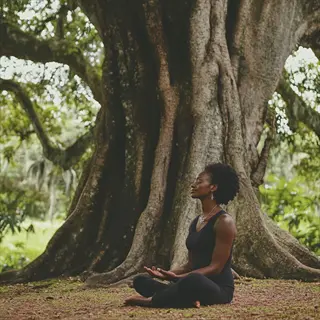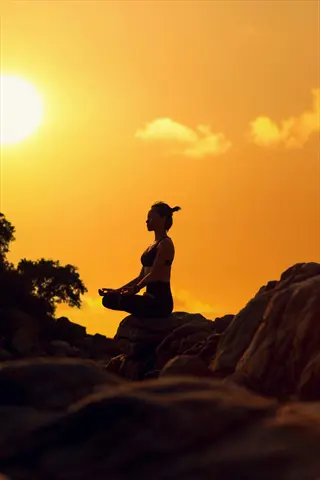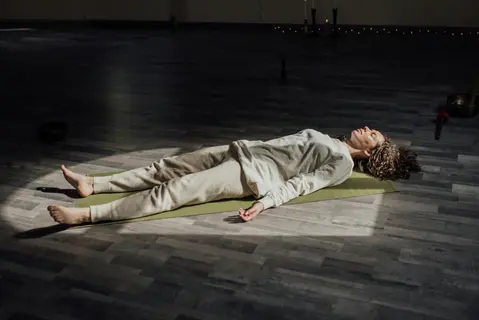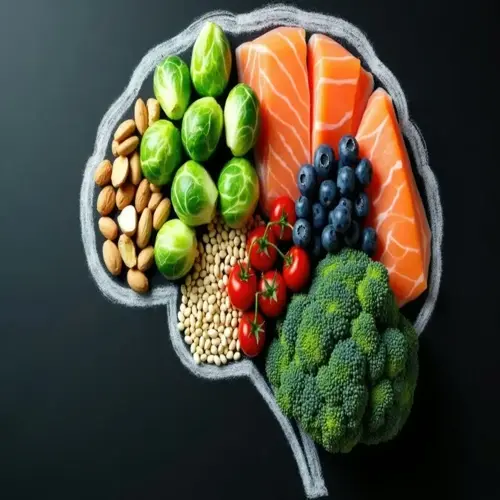10 Meditation Techniques for Beginners

Written by
Tran Quang
Reviewed by
Prof. William Dalton, Ph.D.Beginner meditation techniques emphasize two-minute practices incorporating simple practices every day.
Breath work like the 4-7-8 breathing method offers a straightforward, immediate way to relax from stress and anxiety.
Mindfulness walking and body scans enable focus-building without having to be still.
Practicing consistency through short practices is more important than perfecting long practices.
Even when you are distracted in practice, you can label your thoughts neutrally and switch your positions.
Try different techniques like mantras to find what works for you.
Article Navigation
Learning to meditate for beginners means learning to train your mind just like a muscle. Forget about strange mystical experiences, and instead think of learning how to build concentration and calm. I started out doing only two minutes a day. Real mental strength is built through regular practice.
Progress is better than perfection. Each session gets you better. We will cover ten beginner-friendly methods. These will fit your schedule. Short sessions work. I instruct my students to start small. You will see the changes more quickly than you expect.
Flexibility is essential. Begin with two minutes, anywhere. Use your office chair. Consider a park bench. I often meditate while sitting and waiting for an appointment. The beauty is that you can easily adapt these techniques into your life.
Core Benefits and Setup
Quickly reduce stress with meditation. Studies show a decrease in cortisol hormone levels. This hormone causes tension. In my own life, I noticed a reduction in stress after eight weeks. You learn to deal more effectively with daily pressures. Your body learns to remain calm in the face of adversity.
Maintaining mental clarity will increase your productivity. Meditation helps clear the mental fog, allowing you to make decisions more quickly and tasks to feel easier. Personally, I have clients meditate before starting a big project because they can complete the work in less time and focus with laser-like precision.
Accessibility makes meditation a great option for beginners. You likely need zero equipment. Even short sessions will fit in your schedule. Start small - two minutes is a good place to begin. If you like the chair, happy! If you prefer the floor, happy! I tend to meditate during 5-minute breaks at work, often during my coffee breaks. You can meditate practically anywhere.
Proper posture prevents discomfort. Sit upright but relaxed. Shoulders stay loose. Hands rest on knees. I adjust cushions for students. Your spine needs support. Comfort keeps you focused longer.
Stress reduction
- Regular practice lowers cortisol levels within 8 weeks, improving resilience to daily pressures based on clinical studies.
Mental clarity
- Enhances focus and decision-making abilities by reducing mental clutter during demanding tasks.
Accessibility
- Requires no special tools; effective results achievable in sessions as short as two minutes anywhere.
Emotional balance
- Reduces emotional reactivity to daily triggers through consistent awareness training.
Physical wellness
- Supports lower blood pressure and improved sleep quality with regular practice.
Location selection
- Choose quiet spots like chairs, floors, or beds where you won't be interrupted during practice.
Proper posture
- Maintain upright spine alignment with relaxed shoulders and comfortable hand placement on knees or lap.
Time management
- Begin with two-minute sessions; gradually increase to twenty minutes as comfort with practice develops.
Clothing comfort
- Wear loose, non-restrictive clothing to maintain comfort throughout the meditation session.
Consistency routine
- Attach practice to existing habits like morning coffee or evening wind-down time for sustainability.
Top 5 Meditation Techniques
The 4-7-8 breathing pattern begins with four-second inhalations through the nostrils, followed by holding the breath for 7 seconds. The individual exhales through slightly pursed lips for 8 seconds. This is a technique I teach new students for immediate tranquility.
Body scan starts at your toes. Gradually shift your attention up your legs, torso, arms, and finally your head. Please pay attention to any sensations you feel, only noticing them without judgment. I find this helps release tension. You become conscious of where your stress resides.
Walking meditation involves purposeful, slow steps. Feel your foot lift, move forward, and touch the ground. You notice the air on your skin and the sounds around you. I do this outside daily. It makes an ordinary walk a mindful experience.
Choose a mantra that feels peaceful and calming. Repeat it silently 108 times. Use meditation beads to track counts. I started with 'peace' years ago. Your focus deepens with each repetition.
Mindfulness Essentials trains present-moment awareness. Notice thoughts without following them. Label them 'thinking' then return focus. My clients find that this reduces anxiety fast. You build mental clarity gradually.

Breathing Meditation
- The 4-7-8 technique involves inhaling for four seconds through the nose while maintaining an upright posture with relaxed shoulders and an open chest.
- Breath retention for seven seconds helps activate the natural relaxation response that calms both physical tension and mental distractions effectively.
- Extended eight-second exhalation through gently pursed lips creates a soothing rhythm that releases accumulated stress throughout the entire body system.
- This breathing pattern should be repeated three to four times initially, with frequency increasing gradually as comfort and familiarity with the practice develop.
- Focusing attention on the physical sensation of air moving through nostrils provides a constant anchor point that minimizes mind wandering during sessions.
- Regular application of this method helps lower resting heart rate while promoting calmness during challenging daily situations and activities.

Mindfulness Essentials
- Begin by systematically scanning the body starting from the toes and moving slowly upward to the crown of the head methodically.
- Observe physical sensations like warmth, pressure, or tingling in each area without forming judgments or interpretations about these feelings.
- When thoughts naturally arise during practice, label them neutrally as mental events before gently returning focus to bodily awareness.
- This approach cultivates present-moment attention that reduces emotional reactivity to ordinary stressors encountered throughout daily life experiences.
- Consistent five-minute sessions gradually improve attention control while decreasing anxiety symptoms commonly reported by new practitioners.
- The technique requires absolutely no special equipment and can be practiced virtually anywhere with minimal time investment requirements.

Walking Meditation
- Move at a deliberately slow pace while mentally noting each movement phase: lifting the foot, moving it forward, placing it down carefully.
- Engage fully with environmental sensations - feel ground textures underfoot, notice wind patterns on skin, and listen to ambient nature sounds attentively.
- Maintain natural breathing rhythm while coordinating movement with breath cycles to strengthen mind-body connections during the practice.
- This approach provides excellent options for beginners who experience restlessness during seated positions or traditional meditation formats.
- Twenty-minute outdoor sessions combine meditation benefits with light physical activity advantages for holistic wellness enhancement.
- Concentrating on the mechanical process of walking prevents excessive thinking while cultivating mindful presence in each moment.

Mantra Simplicity
- Select a personally meaningful calming word or phrase such as peace, om, or calm mind that resonates deeply with individual preferences.
- Repeat silently one hundred eight times using traditional mala beads to maintain count without creating mental distraction or confusion.
- Sit comfortably with eyes gently closed, concentrating on the mantra's subtle vibration felt within the chest and head regions.
- Rhythmic repetition establishes neural patterns that help lower heart rate and promote balanced blood pressure levels naturally.
- Morning practice establishes calm mental focus that carries through daily activities and unexpected challenges encountered later.
- This accessible method requires minimal instruction while demonstrating noticeable effects within regular practice over weeks.

Body Scan Guide
- Start systematically at the feet, noticing sensations like sock pressure or floor contact before consciously releasing muscular tension.
- Progress upward methodically through calves, thighs, hips, abdomen, chest, hands, arms, shoulders, neck, and facial areas sequentially.
- Consciously relax each major muscle group for several seconds before moving attention to the next body section deliberately.
- Evening practice prepares the physical system for deeper, more restorative sleep cycles that occur naturally throughout the night.
- Combine with deep breathing by imagining tension dissolving and leaving during exhalation at each scanned body location.
- Brief three-minute versions offer practical stress relief during work breaks or before important meetings requiring mental clarity.
Quick Practices for Busy Lives
Shower meditation utilizes the senses of water as anchors. Feel the temperature change across your skin. Notice the smells of soap as you inhale. I focus on steam patterns and the sounds of echoes. You can turn daily washing into a refreshing, mindful activity.
Try counting your breaths at red lights. Take in and out 10 full breaths. Look around you with a non-evaluative attitude. I use this during train waits. Frustrating interludes become restful ones. The switch on your thought patterns is quickly reset.
Mindful eating is about texture and flavor. Chew slowly and notice the layers of each bite. I focus on one meal item per day to give it my full attention. You discover new dimensions of taste. This also helps encourage gratitude for what is simple and easily accessible to you.
Desk stretch-breaks connect movement to breath. Inhale, raising your arms overhead. Exhale, rolling your shoulders back. I do this every ninety minutes or so. You relieve neck tension and recapture your focus. Just two minutes increases productivity significantly.
Shower Meditation
- Focus fully on water temperature variations across your skin while inhaling soap or shampoo aromas deeply. Notice steam patterns and sound resonance for two minutes without engaging in planning thoughts.
Commute Reset
- During transportation pauses like red lights or bus stops, count ten complete breath cycles while observing surroundings neutrally. Note sky colors, building textures, or passing scenery without narrative judgment to reset mental focus.
Mindful Eating
- Select one meal component daily to eat slowly, noting texture variations, flavor layers, and temperature shifts without distractions. Chew thoroughly and pause between bites to cultivate gratitude and sensory awareness.
Desk Stretch Break
- Every ninety minutes, perform two minutes of seated stretches synchronized with breath cycles: inhale while raising arms overhead, exhale during shoulder rolls. Release neck tension by gently tilting the head side-to-side rhythmically.
Evening Wind-Down
- Before sleep, sit comfortably while mentally reviewing three positive moments from the day without analysis. Breathe deeply, acknowledging each experience before releasing it with exhalations for five minutes.
Handling Challenges
Address mind wandering by labeling your thoughts neutrally as they arise. You can say "thinking" silently in your mind if you are distracted by your thoughts. Then gently redirect your focus back to your breath. I teach this to all beginners. You develop focus through redirection, not due to perfection. This redirection is the fundamental skill we are developing.
Embrace distractions due to noise with little frustration. The picture sounds just like one of the background elements. You can often mask prohibitions with softer sounds from nature recordings. I frequently practice near busy streets, and you appear to practice staying grounded even amid the commotion. This practice also develops mental resilience more than anything.
Overcome consistency barriers by tying practice to routines. For instance, what if you meditated after brushing your teeth or drinking coffee? Additionally, consider tracking practice on a calendar. I started by using sticky notes on my mirror. When building a habit, aim for small, tangible wins that are easy to see.
Make any necessary changes immediately with regard to discomfort. Use pillows or change your position. If pain arises in sitting practice, consider walking meditation. I highly recommend chair meditation for those with back issues. You do not want discomfort to prevent your journey. Comfort can also help with focus.
Mind Wandering
- Gently label distracting thoughts as mental events without judgment, then return focus to your breathing pattern. Remember that frequent refocusing is normal and represents valuable practice.
Noise Distractions
- Accept ambient sounds neutrally by imagining them as background elements rather than interruptions. Consider using soft nature sound recordings if disruptive noises persist during your meditation.
Consistency Barriers
- Anchor meditation sessions to existing daily routines like morning tooth-brushing or coffee preparation. Track progress with simple calendar marks to build motivation through visible commitment patterns.
Physical Discomfort
- Adjust positions frequently using supportive cushions or switching to a comfortable chair. Explore walking meditation techniques if seated postures cause strain during extended practice sessions.
Expectation Pressure
- Release attachment to specific outcomes while focusing instead on maintaining consistent practice. Recognize subtle shifts like slightly calmer reactions to daily stressors as meaningful progress.
5 Common Myths
To be effective and successful in meditation, the mind needs to be completely emptied of thoughts.
Meditation is an activity in which thoughts naturally occur, but this is normal mental activity. The activity requires that thoughts be observed without engaging them rather than eliminating them. Each gentle return to the breath when thoughts are noticed brings the ability to concentrate. It is by consistently redirecting the mind during the activity, which leads to success, rather than striving for perfect quietude in the mind.
If you hope to experience real benefits from practice sessions, you need to spend at least thirty minutes per day meditating daily.
However, stress can effectively be reduced with just two minutes of practice each day for many people. Quality is more important than quantity especially as consistency is of more importance than a long hour or two hour meditation sessions. Regular short session will rewire the patterns of attention. Many novice meditators report they feel more these improvements within a week of daily short meditation periods. The longer periods become easier after regular habits are established.
Meditation is a "spiritual" or "religious" practice requiring specific beliefs to accomplish its benefits.
Modern techniques of meditation are secular means to an end that require no rooting in spirituality. Lots of hospitals, some schools and workplaces all teach mindfulness episodically to help lower stress levels but with no religious connections. The basic process is one of attention regulation, and breath awareness exercises are the tools. The systems are available to anyone without concern as to the beliefs held or not held about spirituality or religion.
You should feel tremendous deep relaxation and dramatic changes of life already after the first periodic meditations that you will have.
The benefits which accrue by regular application. as with the building of the physical body for greater strength and endurance, is a matter of regular practices. The first practice will be found difficult. This arises from the fact that the mind is getting accustomed to new thinking conditions. But in the first place study closely the small change matters. More calmness under nondescript stressers of life now and then, clearer moments in moments of reflection. Life will begin to alter very strongly after practice has gone on for weeks and months.
There is only one right way to meditate and it works for all people and all situations.
Meditation uses different techniques suited to the needs and circumstances of the individual. Breathing techniques help one person and walking or guided techniques another person, depending on his or her frame of reference. Experiment with different kinds of meditation until you find the technique that suits your comfort and sustains itself naturally in your life. Flexibility in methods is a help for long term success more than absolute adherence to some exact means.
Conclusion
Start small. Two-minute sessions. This lowers the bar of entry, making you feel more comfortable and confident, rather than overwhelmed. I started my practice during my lunch breaks. You should be able to see that meditation fits into your life. Consistency breeds change faster than marathon sessions ever could.
Accept that mistakes are part of the process. Minds wander. Bodies fidget. This is normal training. I remind students of this daily. You grow through gentle redirection. Each time you return to focus, you strengthen your mental muscle. This is how mastery develops.
Variety ensures that you can find your perfect fit. Different individuals and times demand different techniques. I swap methods according to my energy levels. Figuring out what fits comes through trial and error. Personalizing your practice makes it sustainable for the long term.
Start your practice today by picking one technique. Set a timer for two minutes. I took this first step twenty years ago. The transformation happens through simple, repetitive action. Your calmer, clearer life is awaiting you.
External Sources
Frequently Asked Questions
How should complete beginners start meditation practice?
Start with two-minute sessions focusing solely on breath awareness. Choose a quiet spot, sit comfortably with upright posture, and gently return attention to breathing whenever distracted. Consistency matters more than duration initially.
What are fundamental meditation techniques for newcomers?
Essential beginner techniques include:
- Breath counting (4-7-8 method)
- Body scanning from feet to head
- Mindful walking with step awareness
- Mantra repetition with calming phrases
- Sensory observation during daily activities
Can meditation be done lying down?
Yes, especially for body scan techniques, but seated positions prevent sleepiness. Use cushions for support if experiencing back discomfort. Lying meditation works well for evening relaxation before sleep.
How do I handle constant thoughts during meditation?
Thoughts are normal - label them neutrally as 'thinking' without judgment. Gently refocus on your breath each time. This redirection process is the core skill development, not thought elimination.
What common mistakes should beginners avoid?
Avoid these pitfalls:
- Expecting immediate dramatic results
- Frustration over mind wandering
- Inconsistent timing and location
- Ignoring physical discomfort signals
- Comparing progress with others
Is there an ideal time of day for meditation?
Morning sessions establish daily calm, while evenings aid sleep transition. Choose times matching natural energy dips. Consistency matters more than specific hours - attach practice to existing routines like toothbrushing.
What physical positions work for meditation?
Effective positions include:
- Sitting cross-legged on cushion
- Using a chair with upright back
- Kneeling with bench support
- Walking slowly with awareness
- Lying down for body scans
How long until beginners notice benefits?
Initial benefits like reduced reactivity to minor stressors often appear within one week of consistent short sessions. Deeper focus and emotional balance develop gradually over several weeks of regular practice.
Can music or apps assist beginner meditation?
Yes, nature sounds mask distractions, and guided apps provide structure. However, transition to unassisted practice builds stronger focus skills. Use tools initially but phase them out over weeks.
What if I fall asleep during meditation?
Sleepiness indicates exhaustion - honor your body's need for rest. For alertness, meditate seated with eyes slightly open. Morning sessions after light activity reduce sleepiness likelihood.

